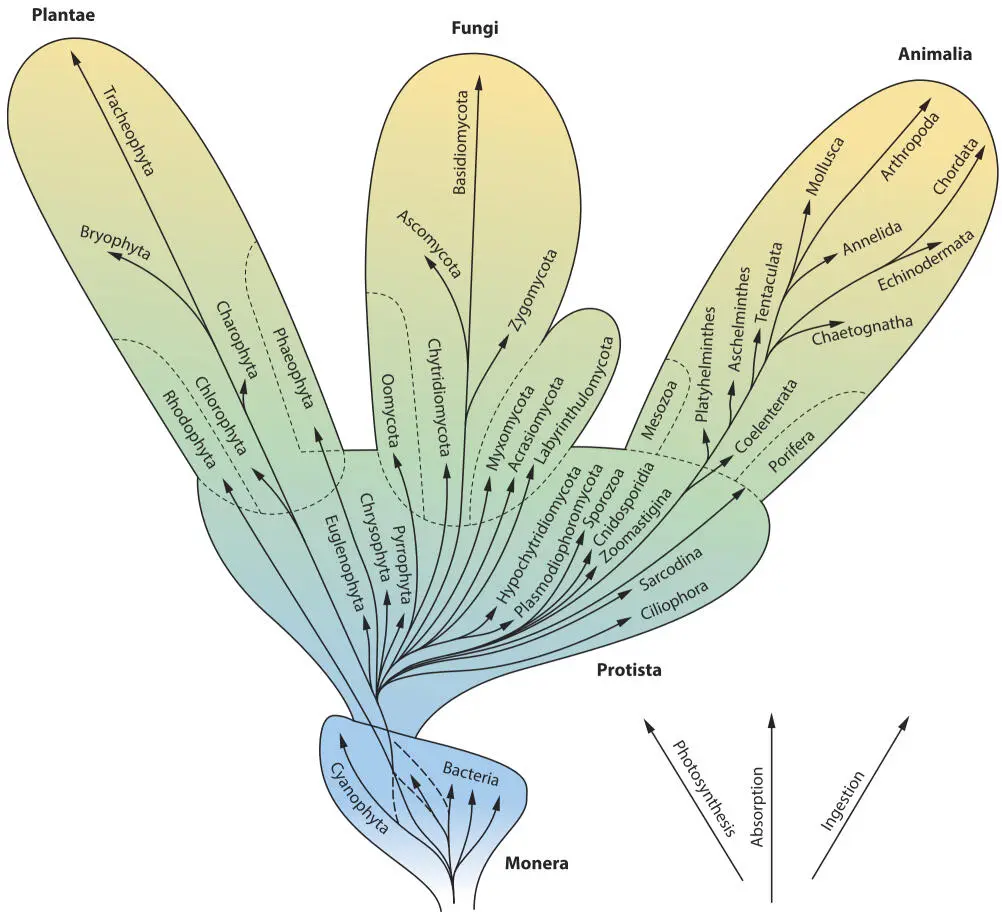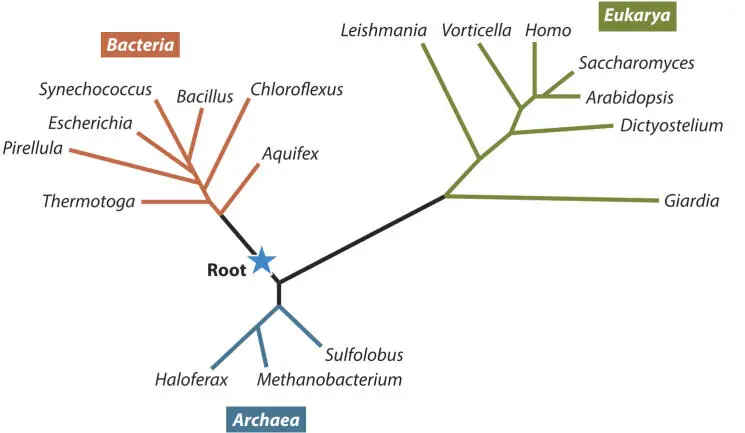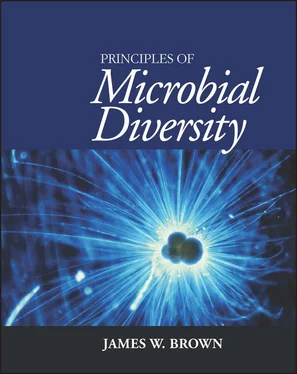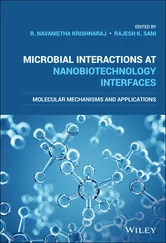1 ...7 8 9 11 12 13 ...21 
Figure 2.4The tree of life. (Reprinted from Ernst Haeckel, Generelle Morphologie der Organismen . G. Reimer, Berlin, Germany, 1866.) doi:10.1128/9781555818517.ch2.f2.4

Figure 2.5The five-kingdom tree taught in most schools in the United States. (Redrawn from Whittaker RH, Science 163:150–160, 1969. Used with permission from AAAS.) doi:10.1128/9781555818517.ch2.f2.5
The reality is that the five-kingdom tree is entirely qualitative and subjective.
Molecular phylogenetic trees
If the traditional five-kingdom tree is problematic because it is subjective and qualitative, we need an objective measure of evolutionary history. With the ability to determine the nucleotide sequences of genes beginning in the 1970s, it became possible to use variation in these gene sequences as molecular chronometers of evolutionary distance. We cover this in much detail in chapters 3through 6, but suffice it to say for now that these sequences provide the information needed to reconstruct evolutionary trees both objectively and quantitatively (Fig. 2.6).
This example of a molecular phylogenetic tree is an unrooted dendrogram. The length of the branches quantitatively represents the evolutionary distance separating gene sequences within these organisms. This particular tree is based on the analysis of small-subunit ribosomal RNA (rRNA) gene sequences. In this tree, the tips of branches are modern organisms. Each node within the tree represents a common ancestor. The last common ancestor (the root) is marked with a star. The way this was determined is described in chapter 7.
Notice that there is no explicit or implied ranking of above (superior) or below (inferior) in the tree. Evolutionary distance (divergence) is measured along the lengths of the branches connecting species. There are no axes in this graph.
One of the most exciting early outcomes of this method was the discovery of a new type of organism: the Archaea (archaebacteria). Previously it was thought that all living things were members of either the Bacteria (eubacteria) or the Eukarya (eukaryotes). Archaeal species had previously been scattered haphazardly among whatever bacteria they superficially resembled. Indeed, in terms of superficial phenotype, the Archaea are generally similar to the Bacteria , but biochemically they are just as similar to the Eukarya , and in evolutionary terms they form a distinct group that is probably more closely related to the Eukarya than to the Bacteria . The Archaea as a group have changed less since their common ancestry than either the Bacteria or Eukarya (they are primitive), and so they more closely resemble our common ancestry.

Figure 2.6Phylogenetic tree of representative organisms based on small-subunit rRNA sequences. (Redrawn from a figure provided by Norman R. Pace.) doi:10.1128/9781555818517.ch2.f2.6
Multicellular eukaryotes, the plants (e.g., Arabidopsis ), animals (e.g., Homo ), and fungi (e.g., Saccharomyces ), are a very small portion of evolutionary diversity in this tree: just the tip of one or two branches of the Eukarya , not three-fifths of evolutionary diversity as the five-kingdom scheme has it. Notice that Eukarya is as ancient a group as is either Bacteria or Archaea and that it did not evolve from either of these other groups. Bacteria are not primitive ancestors of “higher organisms.”
The tree also offers confirmation of the endosymbiont theory for the origin of mitochondria and chloroplasts. These organelles have their own DNA and genes, including small-subunit rRNA genes, and so they can be analyzed separately from the nucleus ( Eukarya ) by molecular phylogenetic analysis. Mitochondria turn out to be members of the proteobacteria (exemplified by Escherichia in this tree), and chloroplasts are members of the cyanobacteria ( Synechococcus in this tree).
A taxonomy is a classification scheme for species (or any other collection of objects, for that matter). There are three related components of a biological taxonomy:
1 1. Grouping: The organization of organisms into groups based on similarity
2 2. Naming: The labeling of organisms and groups of organisms with names
3 3. Identifying: The identification of organisms when they are found
Taxonomies are artificial constructions, methods created and used by humans to organize species. Any self-consistent taxonomy is valid, whether it reflects the natural relationships of the organisms or not.
For example, wildflower field guides organize species by features that are readily observed in the field. The first division might be by flower color, a trivial feature of the plants in evolutionary terms but perfectly reasonable for taxonomy. There is no implication that plants with flowers of the same color are related phylogenetically or that plants with flowers of different colors are not related. The field guide is designed for grouping, naming, and identifying species, and so are useful taxonomies.
A phylogeny is the evolutionary pathway relating species. Think of a phylogeny as a large-scale genealogy of species. Phylogenies represent the actual natural relationships between organisms. They are most commonly displayed graphically in the form of phylogenetic trees.
Unfortunately, there are generally no natural delineations between groups in a phylogenetic tree. However, taxonomists can start with a phylogenetic tree and try to divide it into reasonable groups based on the branches of the tree and the phenotypes of the organisms. In doing so, they attempt to devise a taxonomy that reflects, or at least is consistent with, the phylogenetic relationships between the species.
The classical taxonomies of plants and animals are fairly good representations of the phylogenetic relationships between their members because the intricate morphology of these organisms reveals their ancestry. This is not true for microbes. There was no way to determine evolutionary relationships between Bacteria and Archaea or even between protists, algae, and fungi until the development of molecular phylogenetics, in which phylogenetic relationships are inferred on the basis of gene sequences.
Why is an understanding of phylogeny important?
Thinking about organisms from a phylogenetic perspective is critically important for two reasons:
First, so that you can predict the properties of organisms based on the properties of their relatives. Think about how much insight you can get into a person by getting to know his or her family—this is why meeting the family of someone you’re dating is so important! Understanding an organism’s relationships to other species is the key to understanding its properties.
Second, so that you can prevent inappropriate comparisons based on nonexistent relationships. For example, Euglena was used for years as a unicellular model system to study photosynthesis in green plants. However, it turns out that Euglena is related not to plants but to trypanosomes. Its chlorophyll is not like those of plant chloroplasts and was acquired independently. Chlamydomonas is a better system because it is phylogenetically a unicellular green plant.
Читать дальше















